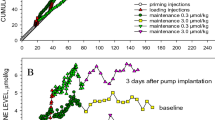Summary
EMD 23,448 was examined in tests of dopaminergic function and was found to be an atypical dopamine (DA) agonist. EMD 23,448 was a weak or inactive DA agonist when examined in tests of normal postsynaptic DA receptor function: production of stereotypy in the rat (ED50>5.0 mg/kg i.p.); production of emesis in beagles (minimum effective dose=81μg/kgi.V.); and, enhanced locomotor activity of the mouse (no excitation in doses <-50 mg/ i.p.). Moreover, EMD 23,448 was relatively weak in competing for [3H]-apomorphine binding to rat striatal membranes (Ki, 205 nM). On the other hand, this indolyl-3-butylamine did activate supersensitive postsynaptic DA receptors. Specifically, it elicited contralateral turning in rats with a unilateral 6-hydroxydopamine lesion of the substantia nigra (ED50 value= 0.9 mg/kg) and did elicit stereotypy in rats given chronic daily haloperidol treatments. EMD 23,448 also exerted pharmacological effects in tests designed to measure activation of dopamine autoreceptors. It inhibited theγ-butyrolactone-induced increase in striatal dopa levels (ED50=1 mg/kg i.p.) and produced a dose-related fall in the locomotor activity of the mouse. The results are discussed and contrasted with data derived for apomorphine and the putatively selective autoreceptor agonist (±)-3-PPP.
Similar content being viewed by others
References
Burt, D. R., Creese, I., Snyder, S. H.: Properties of [3H] haloperidol and [3H] dopamine binding associated with dopamine receptors in calf brain membranes. Mol. Pharmacol.12, 800–812 (1976).
Carlsson, A.: Dopamine receptor agonists: intrinsic activity vs. state of receptor. J. Neural Transm.57, 309–315 (1983).
Cheng, Y., Prussof, W. H.: Relationship between the inhibition constant (Ki) and the concentration of inhibitor which caused 50 percent inhibition (I50) of an enzymatic reaction. Biochem. Pharmacol.22, 3099–3108 (1973).
Chiodo, L. A., Bunney, B. S.: Electrophysiological studies on EMD 23,448, an indolyl-3-butylamine, in the rat: a putative selective dopamine autoreceptor agonist. Neuropharmacology22, 1087–1093 (1983).
Finney, D. J.: Probit Analysis, pp. 50. Cambridge: Cambridge University Press. 1971.
Hefti, F., Melamed, E., Wurtman, K. J.: Partial lesions of the dopaminergic nigrostriatal system in rat brain: biochemical characterization. Brain Res.195, 123–137 (1980).
Hjorth, S., Carlsson, A., Clark, D., Svensson, K. Wikström, H., Sanchez, D., Lindberg, P., Hacksell, U., Arvidsson, L.-E., Johansson, A., Nilsson, J. L. G.: Central dopamine receptor agonist and antagonist actions of the enantiomers of 3-PPP. Psychopharmacology81, 89–99 (1983).
Hjorth, S., Carlsson, A., Lindberg, P., Sanchez, D., Wikström, H., Arvidsson, L. E., Hacksell, U., Nilsson, J. L. G., Svensson, U.: A new centrally acting DA receptor agonist with selectivity for autoreceptors. Psychopharrn. Bull.16, 85–90 (1980).
Martin, G. E., Bendesky, R. J.: Mouse locomotor activity: anin-vivo test for dopamine autoreceptor activation. J. Pharm. exp. Therap.229, 706–711 (1984).
Martin, G. E., Haubrich, D. R., Williams, M.: A pharmacological comparison of 6, 7-dihydroxy-2-dimethylaminotetralin (TL-99) and N-n-propyl-3-(3-hydroxyphenylpiperidine [3-PPP]) with selected dopamine agonists. J. Pharmacol, exp. Therap.223, 298–304 (1982).
Minck, K.-O., Fuchs, A. M., Harting, J., Wolf, H. P.: Pharmacological studies with EMD 23,448 a new dopamine agonist. Acta Pharmaceut. Suec., Suppl. 2, 237–243 (1983).
Neve, K. A., Altar, A., Wong, C. A., Marshal J. F.: Quantitative analysis of [3H]-spiroperidol binding to rat forebrain sections: plasticity of neostriatal dopamine receptors after nigrostriatal injury. Brain Res.302, 9–18 (1984).
Seeman, P.: Brain dopamine receptors. Pharm. Rev.32, 229–313 (1980).
Seeman, P., Lee, T., Chau-Wong M., Tedesco, T., Wong, K.: Dopamine receptors in human and calf brain using3H-apomorphine and an antipsychotic drug. Proc. Natl. Acad. Sci. U.S.A.73, 4354–4358 (1976).
Seyfried C. A., Fuxe, K.: Neuropharmacological and neurochemical effects of 3-[4(4-phenyl-1, 2, 3, 6-tetrahydropyridyl-1)-butyl]indole (EMD 23,448), a new long-acting dopamine agonist. Arzneim.-Forsch. Drug Res.32, 892–893 (1982).
Seyfried, C. A., Fuxe, K., Wolf, H.-P., Agnati, L. F.: Demonstration of a new type of dopamine receptor agonist: an indolyl-3-butylamine. Actions at intact versus supersensitive dopamine receptors in the rat forebrain. Acta Physiol. Scand.116, 465–468 (1982).
Seyfried, C. A., Fuxe, K., Wolf, H. P., Agnati, A. F.: Neurochemical and functional studies with EMD 23,448, a novel dopamine agonist. Acta Pharmaceut. Suec., Suppl.2, 243–248 (1983).
Walters, J. R., Roth, R. H.: Dopaminergic neurons: anin-vivo system for measuring drug interactions with presynaptic receptors. Naunyn-Schmiedeberg's Arch. Pharmacol.296, 5–14 (1976).
Author information
Authors and Affiliations
Rights and permissions
About this article
Cite this article
Martin, G.E., Pettibone, D.J. Dopamine agonist activity of EMD 23,448. J. Neural Transmission 61, 115–123 (1985). https://doi.org/10.1007/BF01253056
Received:
Revised:
Issue Date:
DOI: https://doi.org/10.1007/BF01253056




